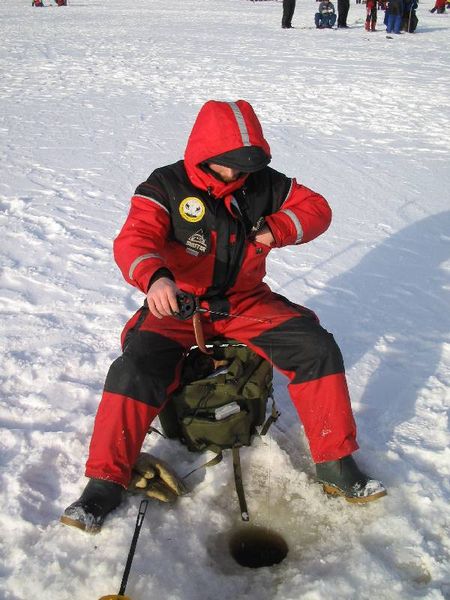
“Thick and blue, tried and true…Thin and crispy, way to risky”.These are definitely words to LIVE by!Whenever you are considering traveling onto the ice, before taking your 1st step; and especially prior to bringing any sort of ‘vehicle’ (snowmobile, car or truck, ice shack, etc.); you should always determine the condition of the ice by looking at it’s color & thickness. You should be looking for ‘bluish’ ice that is at least 4 to 6 inches thick…the minimum it should be in order to support people and their gear. In the winter, as an outdoor enthusiast…you need to know how thick the ice is and whether it is SAFE to walk on.
Below are the Maine Dept. of Inland Fisheries & Wildlife’s General Ice Thickness Guidelines (For New, Clear Ice Only!)
- 2″ or less – STAY OFF!
- 4″ May allow Ice fishing or other activities on foot
- 5″ often allows for Snowmobile or ATV travel
- 8″ – 12″ of good ice supports most cars or SMALL pickups
- 12″ – 15″ will likely hold a Medium sized truck.
To find out more of their suggestions on their “ICE SAFETY” page click on the link to the Maine Dept. of Inland Fisheries & Wildlife website.
OTHER ICE SAFETY INFORMATION WE FOUND From the Maine.gov website link to Snowmobile Laws & Rules:
Even if the weather has been below freezing for several days, DO NOT guess about ice thickness. You should be checking the ice in several places, using an auger, spud, or axe by making a test hole. This should be done beginning at the edge of the shore and continuing as you move further out onto the body of ice. If the ice right at the shoreline appears cracked or feels ‘mushy’ at all…STAY OFF THE ICE!
- Watch out for thin, clear, or ‘honeycomb-shaped’ ice.
- ‘Dark snow’ and ‘Dark Ice’ are other signs of weak spots.
- DO NOT go on the ice during thaws.
It is better to choose to go on the ice of smaller bodies of water. Rivers and lakes are prone to wind and wave action, which can break the ice up quicker. Avoid areas with currents, around bridges, and pressure ridges.
What to do if you break through the ice. There is even more potentially life-saving information about what to do if this happens on Maine Dept. of Inland Fisheries & Wildlife’s website.
- If you break through the ice, DON’T panic.
- DO NOT try to climb out…you’ll probably break through the ice again.
- Lay both arms on the unbroken ice and kick HARD!…this will help lift your body onto the ice.
- ROLL to safety.
To help someone who has fallen through the ice.
- Lie down flat on the ice and reach with a branch, plank, or rope; DO NOT stand! Or form a human chain.
- After securing the victim, wiggle backwards to where there is solid ice.
- The victim may need treatment for hypothermia (cold exposure), and they may need artificial respiration, and/or CPR.
The quote, “If your feet are cold, put on your hat”…may seem odd…but it’s good advice! Most body heat is lost through the head and neck. So wear a hat, cover your face and neck.
- Dress in layers.
- Wool, silk, and certain synthetics are best; they’ll keep you warm even if they’re wet.
- Insulated, waterproof boots, gloves, and a windbreaker are very important.
- Take extra clothing.
ICE THICKNESS CHART FOR DETERMINING ICE SAFETY
Use this chart as a guideline for choosing to walk or take specific types of vehicles onto the ice.
| Ice Thickness (in inches) |
Permissible Load – Clear, Blue Lake Ice (Reduce strength values for other types of ice) |
| 2” | One person on foot |
| 3″ | Group of people walking single file |
| 7 – 1/2“ | Passenger car (2 ton gross) |
| 8″ | Light truck (2 1/2 ton gross) |
| 10″ | Medium truck (3 1/2 ton gross) |
| 12″ | Heavy truck ( 7 – 8 ton gross) |
| 15″ | Heavy truck ( 10 ton gross) |
| 20″ | 25 tons |
| 25″ | 45 tons |
| 30″ | 70 tons |
| 36″ | 110 tons |
RECREATION · SNOWMOBILING